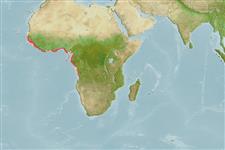Teleostei (teleosts) >
Gadiformes (Cods) >
Moridae (Morid cods)
Etymology: Physiculus: Diminutive of Greek, physa = tube.
Eponymy: André Hulot, an agronomist and hydrobiologist with Institut National pour l’Etude Agronomique du Congo, collected fishes in the Congo River basin (1946). [...] (Ref. 128868), visit book page.
More on author: Poll.
Environment: milieu / climate zone / depth range / distribution range
Ecology
Marine; benthopelagic; depth range 92 - 320 m (Ref. 57178). Tropical; 18°N - 11°S
Eastern Atlantic: Mauritania to Angola (about 18°N to about 11°S).
Size / Weight / Age
Maturity: Lm ? range ? - ? cm
Max length : 18.0 cm SL male/unsexed; (Ref. 4495)
Found in the outer edge of the shelf (Ref. 4495). Minimum depth from Ref. 58018.
Life cycle and mating behavior
Maturity | Reproduction | Spawning | Eggs | Fecundity | Larvae
Cohen, D.M., 1990. Moridae. p. 520-523. In J.C. Quero, J.C. Hureau, C. Karrer, A. Post and L. Saldanha (eds.) Check-list of the fishes of the eastern tropical Atlantic (CLOFETA). JNICT, Lisbon, SEI, Paris; and UNESCO, Paris. Vol. 2. (Ref. 4495)
IUCN Red List Status (Ref. 130435: Version 2024-1)
Threat to humans
Harmless
Human uses
Fisheries: of no interest
Tools
Can't connect to MySQL database fbquizv2. Errorcode: Too many connections
